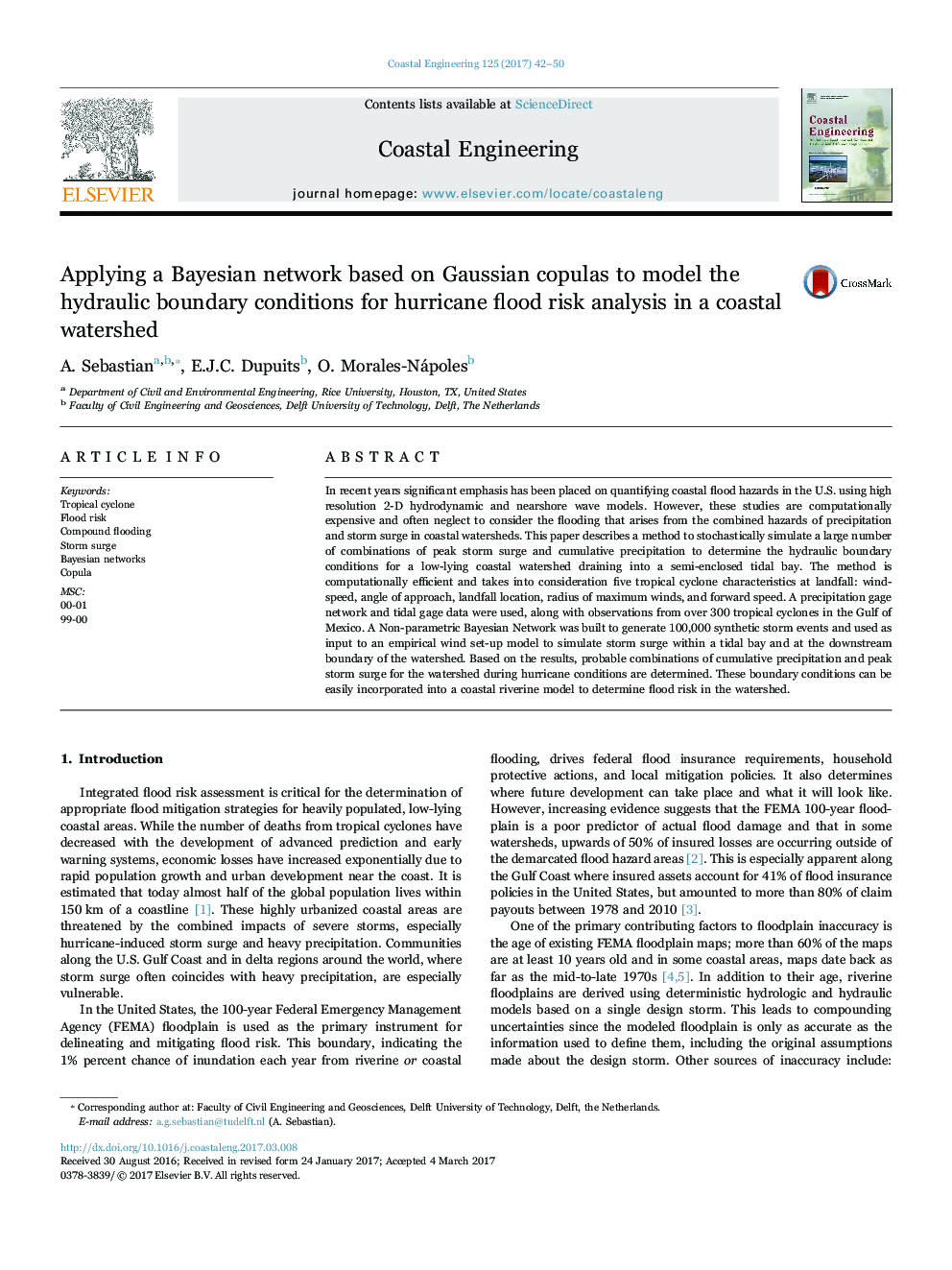| کد مقاله | کد نشریه | سال انتشار | مقاله انگلیسی | نسخه تمام متن |
|---|---|---|---|---|
| 5473475 | 1520329 | 2017 | 9 صفحه PDF | دانلود رایگان |
عنوان انگلیسی مقاله ISI
Applying a Bayesian network based on Gaussian copulas to model the hydraulic boundary conditions for hurricane flood risk analysis in a coastal watershed
ترجمه فارسی عنوان
اعمال یک شبکه بیزی براساس کوپولهای گاوسی برای مدلسازی شرایط مرزی هیدرولیکی برای تحلیل ریسک سیلاب طوفان در یک حوضه ساحلی
دانلود مقاله + سفارش ترجمه
دانلود مقاله ISI انگلیسی
رایگان برای ایرانیان
کلمات کلیدی
سیکلون گرمسیری، خطر سیل، سیل مواد مخدر، موج طوفان، شبکه های بیزی، کاپولا، 00-01، 99-00،
ترجمه چکیده
در سال های اخیر، استفاده از مدل های موج های هیدرودینامیکی با شدت بالا و دوشاخهای دوشاخهای غیرمستقیم با تاکید بر اهمیت سوانح ساحلی در ایالات متحده، تاکید شده است. با این حال، این مطالعات محاسباتی گران هستند و اغلب توجه به سیلاب هایی که از خطرات بارش و بارندگی های طوفان در حوضه های ساحلی بوجود می آیند غفلت می کنند. در این مقاله یک روش برای تصحیح تصادفی تعدادی از ترکیبات بارز پهناور طوفان و بارندگی تجمعی را برای تعیین شرایط مرزی هیدرولیکی برای تخلیه حوضه های کم عمق ساحلی به یک جزر و مد دریایی نیمه بسته محاسبه می کند. این روش به صورت محاسباتی کارآمد است و با توجه به ویژگی های پنج طوفان استوایی در فواصل زمانی مختلف: سرعت باد، زاویه دید، موقعیت زمین، شعاع حداکثر باد و سرعت جلو. شبکه داده بارگیری و داده های داده های جزر و مدی همراه با مشاهدات بیش از 300 سیکلون گرمسیری در خلیج مکزیک مورد استفاده قرار گرفت. یک شبکه غیر پارامتری بیس بیس برای تولید 100000 رویداد طوفان مصنوعی ساخته شده است و به عنوان ورودی به مدل تجربی باد سازی برای شبیه سازی موج انفجار طوفان در خلیج جزر و مد و در مرز پایین آب رودخانه استفاده می شود. بر اساس نتایج، ترکیب احتمالی بارندگی تجمعی و افزایش انبساط طوفان در حوزه آبخیز در شرایط طوفان تعیین می شود. این شرایط مرزی می تواند به راحتی در مدل رودخانه های ساحلی به منظور تعیین خطر سیلاب در حوزه آبریز مورد استفاده قرار گیرد.
موضوعات مرتبط
مهندسی و علوم پایه
سایر رشته های مهندسی
مهندسی دریا (اقیانوس)
چکیده انگلیسی
In recent years significant emphasis has been placed on quantifying coastal flood hazards in the U.S. using high resolution 2-D hydrodynamic and nearshore wave models. However, these studies are computationally expensive and often neglect to consider the flooding that arises from the combined hazards of precipitation and storm surge in coastal watersheds. This paper describes a method to stochastically simulate a large number of combinations of peak storm surge and cumulative precipitation to determine the hydraulic boundary conditions for a low-lying coastal watershed draining into a semi-enclosed tidal bay. The method is computationally efficient and takes into consideration five tropical cyclone characteristics at landfall: windspeed, angle of approach, landfall location, radius of maximum winds, and forward speed. A precipitation gage network and tidal gage data were used, along with observations from over 300 tropical cyclones in the Gulf of Mexico. A Non-parametric Bayesian Network was built to generate 100,000 synthetic storm events and used as input to an empirical wind set-up model to simulate storm surge within a tidal bay and at the downstream boundary of the watershed. Based on the results, probable combinations of cumulative precipitation and peak storm surge for the watershed during hurricane conditions are determined. These boundary conditions can be easily incorporated into a coastal riverine model to determine flood risk in the watershed.
ناشر
Database: Elsevier - ScienceDirect (ساینس دایرکت)
Journal: Coastal Engineering - Volume 125, July 2017, Pages 42-50
Journal: Coastal Engineering - Volume 125, July 2017, Pages 42-50
نویسندگان
A. Sebastian, E.J.C. Dupuits, O. Morales-Nápoles,
